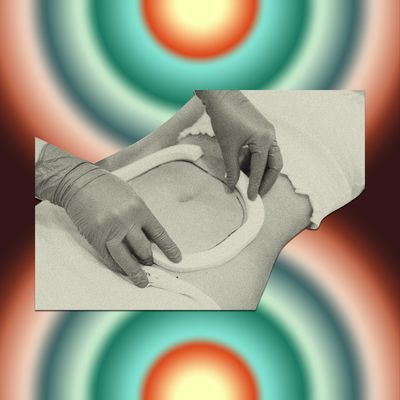
Hi, Beauty Editor,
I’m interested in some sort of nonsurgical treatment to get rid of extra fat on my stomach and thighs. I’m a healthy weight, but those areas still bother me. I’ve read about all the possible side effects of CoolSculpting, so I don’t want to do that. Are there any safer or newer options?
Thanks for your help,
Anonymous
When it comes to dealing with stubborn fat, you’d think modern science would have a way to fix problem spots without surgery, right? “Unfortunately, not yet,” says board-certified plastic surgeon Adam Kolker, M.D. I know that’s hard to believe — especially in the age of Ozempic — but for most people, nonsurgical body contouring isn’t that effective. CoolSculpting, EmSculpt Neo, TruSculpt, SculpSure, VelaShape — Kolker has researched all of them. “The nonsurgical modalities either don’t work, work unreliably and unpredictably, or have an unacceptable risk profile,” he says. “For the majority of people, suction-assisted lipectomy, or liposuction, is the answer.” And he’s not just saying that because he’s a surgeon who performs liposuction. Nicole Frontera, a nurse practitioner who practices aesthetic medicine, also told me that the majority of people who come to her in your same situation would probably be happier with liposuction.
What is CoolSculpting?
CoolSculpting is a minimally invasive procedure that is said to destroy fat cells via cryolipolysis — basically freezing them with a device that won’t damage your skin in the process. If you’re a good candidate for the treatment (see above), you may see up to a 25 percent reduction in fat cells in the weeks and months after your first session, as your body metabolizes the fat cells destroyed by the freezing temperatures. CoolSculpting costs vary greatly, but one session on a small area (such as one of your thighs) typically starts at $650; to treat your stomach and both thighs, you’ll probably spend at least $2,000.
So does CoolSculpting actually work?
Kinda. Nonsurgical body-contouring treatments like CoolSculpting are only effective on people who are at their ideal weight and have residual spots of fat that are diet- and exercise-resistant. “Unfortunately, the companies [that make body-contouring devices] market to everyone, and the treatments are not for everyone. It’s frustrating,” says Frontera. “I spend a lot of time educating people about what is actually possible.”
What are the complications?
I get why you might not want to try CoolSculpting. In very rare cases, like Linda Evangelista’s, the procedure can leave patients with fatty deposits (the complication is called paradoxical adipose hyperplasia, and it may affect up to 0.39 percent of people). But, in general, CoolSculpting has minimal side effects and isn’t painful for most people.
Does EmSculpt Neo work?
Another option you might consider is EmSculpt Neo. “If someone’s already fairly fit, it can be a nice way to tighten those targeted little areas by building muscle and also reducing fat,” says Frontera. During the treatment, a practitioner uses the device to deliver high-intensity focused electromagnetic (HIFEM) energy to stimulate muscle contractions and radio-frequency (RF) energy, which may, for some people, offer subtle fat reduction and a skin-tightening effect. Kolker says the RF results are unpredictable (“talk to a surgeon to see if you’re a candidate”) and that HIFEM is “great for muscle contraction but so are crunches and planks.”
EmSculpt Neo doesn’t hurt, but you may be sore after the treatment. In a best-case scenario, you can see up to a 30 percent reduction in fat after four treatments, according to the manufacturer’s clinical data. Treatments generally cost about $1,000 each, though some clinics and offices will offer discounts for a package of multiple treatments.
Does SculpSure work?
Another option you might consider is SculpSure, a noninvasive treatment that reduces fat beneath the skin with hyperthermic-laser energy (basically, heating the fat to destroy it, whereas something like CoolSculpting freezes the fat to destroy it). Frontera says it may be effective for people who are pretty much at their ideal body weight and are just looking to tone stubborn spots. (Kolker says hyperthermic-laser treatments are minimally effective at best and “not convincing for fat removal.”)
SculpSure treatments may cause some discomfort (the device cools the skin as it heats the fat layer underneath), but there’s no down time after the procedure. The manufacturer reports that patients can see up to a 24 percent reduction in fat eight to 12 weeks after treatment (and you can get multiple treatments for better results). The treatment is usually more expensive than EmSculpt Neo, at about $1,500 to $2,500 per session.
There are other types of fat-reducing devices and off-label injections, but the results are even less impressive than the ones I outlined above. Ultimately, if the fat spots really bother you, you may want to think about liposuction.
Is liposuction worth it?
For most people — even those at a healthy weight, like you — liposuction is still the most effective way to get rid of unwanted pockets of fat. “Liposuction techniques are performed through minute access sites, and while it requires anesthesia, it is minimally invasive, with relatively rapid recovery and short downtime,” says Kolker. On top of that, the results are quantifiable, because your surgeon will know exactly how much fat they’re removing. And many surgeons will now use liposuction in conjunction with other modalities that help with skin tightening and improve the overall results. Of course, there are more risks, more down time, and surgery costs more up front, so I totally understand why you’d want to avoid it.
As you do your research, my final word of advice would be not to base your expected results on images you’ve seen in the manufacturer’s before and after photos (which are always the absolute best-case scenario) or pictures of celebrities or influencers who claim to have gotten body-contouring treatments. “They could have had different treatments than they’re sharing,” says Frontera. As someone who has interviewed dozens of plastic surgeons and heard what they’ve had to say both on and off the record, I feel comfortable putting my assessment in even simpler terms: If it looks too good to be true, it was probably liposuction.
Send your questions to AskABeautyEditor@nymag.com. (By emailing, you agree to the terms here.)





